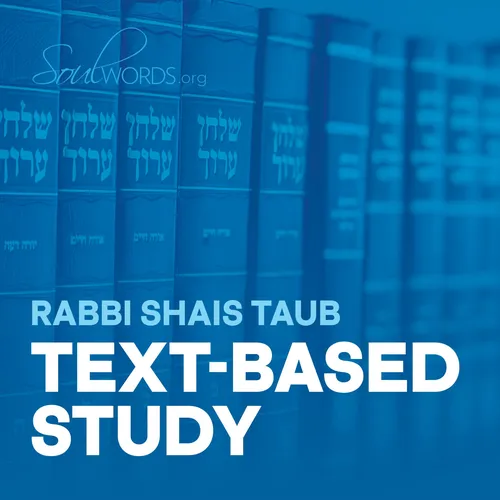
Text-Based Study- SoulWords
SoulWords provides Torah classes and lectures from renowned teacher, Rabbi Shais Taub, on a wide range of spiritual topics.
- Update frequency
- every 6 days
- Average duration
- 53 minutes
- Episodes
- 51
- Years Active
- 2017 - 2025

Vayishlach Yehoshua 5736
The Rebbe's Maamar "Vayishlach Yehoshua" was first delivered on 28 Sivan, the anniversary of the Rebbe and Rebbetzin's arrival in the USA. The discourse examines the Biblical stories of the spies sen…

Baad Kodesh: Class 5
We conclude our study of this work with chapters 7 and 8 in which the Mitteler Rebbe explains why the ruler is in a unique position to give a true and just ruling on his case.

Baad Kodesh: Class 4
In chapters 5 and 6 of the discourse we examine the quality of Malchus (royalty) and explain how it is, like Tiferes, a representation of the "central vector."

Baad Kodesh: Class 3
In this class we cover chapters 3-4 of the discourse and examine more deeply the idea of the "middle vector" called Tiferes.

Baad Kodesh: Class 2
Toward a better understanding of the spiritual mechanisms behind governmental power, Chapter 2 of the Mitteler Rebbe’s discourse, focuses on the three axes—right, left, and center—within the Sefiros.

Baad Kodesh: Class 1
The Mitteler Rebbe’s letter known as Baad Kodesh was written to appeal for justice during his imprisonment, and explains how Divine authority flows through earthly rulers to enable just governance. I…

Ani L'Dodi 5726: Class 4
Through teshuvah, even those far from holiness can reveal their inner connection to G‑d, elevating the Thirteen Attributes of Mercy.
We study Chapters 7-8 and conclude the maamar.

Ani L'Dodi 5726: Class 3
In this part of the maamar, the Rebbe explains how the "king in the field" analogy does not depict an "arousal from Above" inasmuch as it only reveals that which the people had inside of them all alo…

Ani L'Dodi 5726: Class 2
The Rebbe gives a novel interpretation of the reason for the king's smile in the Alter Rebbe's famous parable of the King in the Field.
Chapters 4 and 5.

Ani L'Dodi 5726: Class 1
In this maamar, the Rebbe revisits the Alter Rebbe's famous maamar Ani L'Dodi which employs the metaphor of the king in the field to explain the uniqueness of Elul. We begin by contrasting Elul with …

Tzion B'Mishpat Tipadeh 5736: Class 4
In this class we conclude the maamar with the study of chapters 8 and 9. We learn how there are two levels of redemption that each of us must go through and how these correspond to the redemption in …

Tzion B'Mishpat Tipadeh 5736: Class 3
The possibility for forgetting Torah derives from a viewpoint that perceives a separation between transcendent and the immanent Divine energies. This is also the root of the debacle of the worship of…

Tzion B'Mishpat Tipadeh 5736: Class 2
The unification of Sovev and Memaleh can also be understood as corresponding to the names Havaye and Elokim. This unification makes it possible to live within time and space but not prioritize the ma…

Tzion B'Mishpat Tipadeh 5736: Class 1
This maamar of the Rebbe is based on a maamar of the Alter Rebbe in Likkutei Torah which describes how to instill in oneself the feeling that the Torah is truly new everyday.
Chapters 1-3 of the m…

Vayidaber Elokim 5729: Class 5
In the final two chapters of the maamar, we learn that the level of selflessness achieved through our Torah study after the Giving of the Torah surpasses that of the Avos. Furthermore, through Torah …

Vayidaber Elokim 5729: Class 4
In chapters 7 and 8 of the maamar we continue to contrast the way that Torah was accessible to the Patriarchs and the way in which we are able to access it now after Matan Torah. In the words of the …

Vayidaber Elokim 5729: Class 3
In chapters 5 and 6 of the maamar we learn about the way that the events of Matan Torah permanently changed reality and how this is reflected in three aspects: 1) the Giver of the Torah, 2) the recip…

Vayidaber Elokim 5729: Class 2
Chapter four of the maamar explains the meaning of the four letters of Hashem's name and describes how they are expressed not only in the soul but in the body as well.

Vayidaber Elokim 5729: Class 1
This maamar was originally delivered by the Rebbe on the second day of Shavups 5729 (1969.)
In this class, we cover the first three chapters of the maamar in which the Rebbe begins to analyze a ma…

Kol Yisrael 5733: Class 3—Mitzvos, the Body, and Moshiach
Torah is the wisdom of Hashem while mitzvos are His will. This idea will help us to understand why there are various different levels of Torah study but when it comes to mitzvah observance all Jews a…